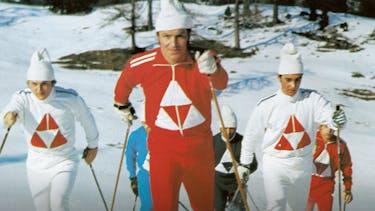1970 is the year in which a very special Fischer success story begins: the ski factory in Ried starts manufacturing cross-country skis – and thus intruding into a Scandinavian domain. The scene is set for Fischer's meteoric rise to the world market leader in Nordic skiing.
"I reckoned it was an easy sport to try out, and a feasible alternative in the lowlands here, too. Kästle and Kneissl had shut production down, which gave us new opportunities. And of course I was able to implement my ideas in this field, too," Josef Fischer recalls. "I was in Scandinavia at that time to inspect various factories. But I saw no signs of development taking place there, which is why I sketched a first idea for a ski during the flight home. That was the 'Europa 77'."
At this point the "Europa 77" is really revolutionary. It consists of a laminated wooden core wrapped in fibreglass elements. The Scandinavians are fabricating all-wooden cross-country skis, which are heavier and break easily. Fischer aims to capture the cross-country ski market with modern technology. In winter 1971 the new ski is put through its first real test: Vienna to Nice, crossing the Alps – the total difference in altitude to be overcome is 85,000 metres. The members of the expedition are looking for a reliable, unbreakable ski for touring and trails. The leader of the expedition, Robert Kittel, decides in favour of the "Europa 77", which passes the endurance test with flying colours. Fischer uses the experience gained on this expedition to put together the first cross-country collection for the 1971/72 season; it is presented at the ISPO in Munich in 1971.
Along with the "Europa 77" trekking ski, Fischer develops the "Europa Racing" racing ski, which will open up the road to top-class cross-country skiing. The French biathlete Daniel Claudeon uses the "Europa Racing" in Sapporo in 1972 – the first time that it appears at the Olympic Games. The following year Fischer equips a number of national teams in Central and Eastern Europe. The definitive breakthrough occurs in 1974 at the Nordic World Championships in Falun in Sweden, when a third of the competitors choose "Europa Racing". Fischer collects seven medals in all. The plastic ski prevails over the wooden ski once and for all. The Scandinavians' wooden contact surfaces turn out to be unsuitable for extreme conditions and temperatures above zero. Fischer's successes lead people to think again even in the original home of Nordic skiing. The Swedish, Finnish and Norwegian Ski Pools open up to Austrian products – for Fischer the bridgehead for capturing the important Scandinavian market.
At the World Championships in Falun Fischer also attracts attention independently of the results of the contests. "Thanks to Fischer, advertising appeared at the start and finish for the first time. We put 'Fischer' on the banner over the finishing line. In those days that cost us 30,000 schillings. Never mind who won the race – in the media Fischer was the winner every time," Gerhard Thaller, Fischer's legendary Nordic racing specialist, recalls.

As in cross-country skiing, Fischer sets new standards in ski jumping in the 1970s. Even in the early days Fischer fabricates small quantities of wooden skis for jumping.
However, the production of skis for jumping is soon closed down; in 1966 not a single Austrian manufacturer is making this type of ski. In 1974, though, Fischer spontaneously reenters ski jumping. This restart is closely associated with the name of Baldur Preiml. At a school with a special focus on skiing Preml is given the chance to train talented young ski jumpers all year round. With modern training methods – he particularly emphasises psyche and diet – Preiml counts as the man behind the Austrian ski jumper miracle. Concentration exercises and training in relaxation are introduced. Instead of roast pork and schnitzel the jumpers get salads, muesli and wholemeal.
Fischer makes an important contribution to this Austrian breakthrough in performance, in the shape of a new design of jumping ski. A new surface layer is developed for the contact surfaces, and the inner structure features soft shovels and segments of differing stiffness – in contrast to competing products from other countries. Fischer succeeds in adapting experience in fabricating Alpine skis to the much longer and heavier jumping ski. Fischer customises skis specially for the young Austrian eagles such as Toni Innauer, Karl Schnabl or Willi Pürstl, each of whom gets their own individually perfected ski.
Initial successes are posted as early as the 1974/75 season. The Austrians win at the Four Hills Tournament and at Holmenkollen. The climax is at the 1976 Olympics in Innsbruck where Karl Schnabl and Toni Innauer win three medals on Fischer skis. Schnabl is the Olympic winner in the 120-metre jump, sailing to 97.5 and 97 metres and forcing his teammate Innauer into second place.
With these successes in the 1970s Fischer sets the stage for a trajectory that has continued to this day. In 2024, the company's 100th anniversary, Fischer is the clear number one in competitive Nordic skiing.




